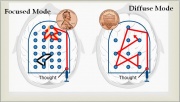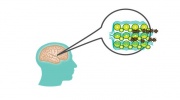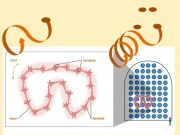User:Brian.Sikute/Upcoming Projects/Sandbox/lhtl
Learning How to Learn
Hi! Welcome to the Learning How to Learn wiki. This wiki will give you practical insight on how to learn more deeply and with less frustration by looking at two modes of thinking, chunking, sleep and dealing with procrastination. This is an adaptation from the Coursera Course – Learning How to Learn
the following are the objectives:
|
Focused and diffuse modes of thinking
Learning occurs somewhat different from how we ordinarily think it does. We are familiar with learning through reading books or seating in a lecture room. However, learning also happens in time when are having fun like watching your favorite comedy TV show or swimming.
Two modes of thinking are discussed: Focused and diffuse modes of thinking.
| The focused mode involves a direct approach to solving problems using rational, sequential, analytical approaches. It is associated with a high level of concentration |
Think of it more like a pinball machine that has bumpers which are very tightly grouped together, so the pinball (the thought) can't go very far without bumping into a bumper. The thought pattern is familiar and we are able to easily connect them.
What happens when you are learning some new? Your brain does not yet have thought patterns. Learning is about creating these patterns. To grasp a new thought, a different approach is needed - the diffuse mode.
| In this diffuse mode of thinking, you can look at things broadly from a very different, big-picture perspective. You make new connections traveling along new pathways |
This is analogous to pinball machine with widely spaced the rubber bumpers are. Thought takes off and can travel long before hitting a bumper.
In the diffuse mode, the brain makes random connections in a relaxed fashion. This mode can be aroused by doing a somewhat mind-numbing activity like
|
Research has also shown that exercise seems to be just as important as an enriched environment in allowing the brain to remain healthy. This reduces the level of concentration allowing you to disconnect from focused mode and kick start the diffuse mode.
At any one time, you're either in the focused mode or the diffused mode of thinking. It seems you can't be in both thinking modes at the same time.
When you get stuck trying to figure out the solution to a problem, simply take your attention off by taking a break. Water the lawn or change a diaper. In the background, the brain continues to work on the problem without your conscious knowledge.
Importance of Sleep
Sleep is very important.
Sleeping allows the brain to do cleanse itself from these toxins. Now you understand why taking that test without sleeping is a bad practice. You are operating with a brain with metabolic toxins. It is also a good idea to go over what you learning right before sleep. You are likely to dream about it.
Procrastination
Apparently everybody has some issues with procrastination. So how do we deal with it? With proper prioritization and allowing for a little relaxation time in your life!--your problems with procrastination can be minimized.
| The Pomodoro technique is an effective way to tackle procrastination. The technique involves setting a timer and working intently, without interruption, for 25 minutes. During the time you are doing a "Pomodoro," you want to try to focus as intently as you can on what you are working on.
|
Learning and Procrastination
When procrastination is an issue, your challenge sometimes is to avoid focusing on the product. The PRODUCT is what triggers the pain that causes you to procrastinate. To prevent procrastination, you want to avoid concentrating on product. Instead, your attention should be on building processes. The word "product" is defined as an "outcome"—for example, a homework assignment that you need to finish. Processes relate to simple habits—habits that coincidentally allow you to do the unpleasant tasks that need to be done
Pay attention for procrastination cues and remove yourself from environments that contain many distractions and procrastination cues. The best approach is to minimize your exposure to distractions. Willpower is a precious resource, and you don't want to waste it on constantly fending off unnecessary distractions. Distractions sometimes arise despite our best efforts. In that case, it's best to not get annoyed by the distraction, but to instead just let it drift by and get right back to your work
Chunking
What is a chunk? When you first look at a brand new concept it sometimes doesn't make much sense, as shown by the jumbled puzzle pieces here.
| Chunking: is the mental leap that helps you unite bits of information together through meaning. |
One of the first steps toward gaining expertise in academic topics is to create conceptual chunks—mental leaps that unite scattered bits of information through meaning. When we retrieve knowledge, we’re not being mindless robots—the retrieval process itself enhances deep learning and helps us begin forming chunks. Chunking helps your brain run more efficiently. Once you chunk an idea, concept, or action, you don’t need to remember all the little underlying details; you’ve got the main idea—the chunk—and that’s enough.
You create a chunk if when you don’t understand but it’s often a useless chunk that won’t fit in with or relate to other material you are learning. Understanding is an important part of chunking. Understanding coupled with practice and repetition in a variety of contexts is what is needed to make a chunk.
Basically, what people do to enhance their knowledge and gain expertise is to gradually build the number of chunks in their mind—valuable bits of information that they can piece together in new and creative ways
| Transfer is the idea that a chunk you’ve mastered in one area can often help you much more easily learn chunks of information in different areas that can share surprising commonalities. |
Chunks can help you understand new concepts. This is because when you grasp one chunk, you will find that that chunk can be related in surprising ways to similar chunks not only in that field, but also in very different ways. The best chunks are ones that are so well-ingrained that you don’t have to consciously think about connecting the neural pattern together. That, actually, is the point of making complex ideas, movements or reactions into a single chunk.



